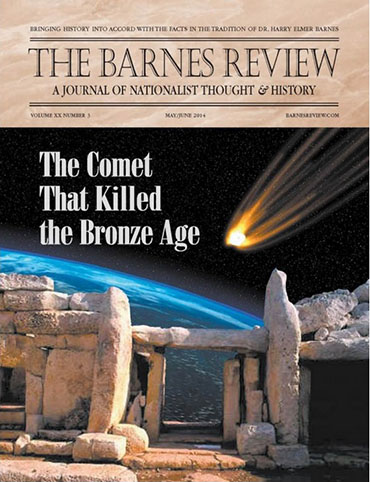
The Barnes Review May/June 2024
$7.00 – $12.00
The Barnes Review
A JOURNAL OF POLITICALLY INCORRECT HISTORY
MAY/JUNE 2024 ❖ VOLUME XXX ❖ NUMBER 3
TABLE OF CONTENTS
THE ATTACK ON WASHINGTON THAT NEVER CAME
IF THEY HAD LISTENED TO FORREST, THEY MIGHT JUST HAVE WON
THE CONFEDERATE CONSTITUTION: WAS IT BETTER THAN OURS?
TOP CONFEDERATE EXPLAINS REAL REASONS FOR THE WAR
ATTORNEY SAM DICKSON ON THE FUTURE OF WHITE AMERICA – INTERVIEW CONDUCTED BY JAMES EDWARDS
SLAVE-OWNING MULATTOES IN ANTEBELLUM SOUTH CAROLINA
THE IMPACT OF THE CIVIL WAR AND RECONSTRUCTION ON THE INDIAN
THE CIVIL WAR AND THE CRUSADE AGAINST NAZI GERMANY
THERE’S NO PLACE LIKE HOME: REFLECTIONS ON THE SOUTH
REBEL NAVAL SECRETARY TRIES TO MODERNIZE C.S.A. NAVY.
- Description
- Additional information
Description
The Barnes Review
A JOURNAL OF POLITICALLY INCORRECT HISTORY
MAY/JUNE 2024 ❖ VOLUME XXX ❖ NUMBER 3
TABLE OF CONTENTS
THE ATTACK ON WASHINGTON THAT NEVER CAME
BY MARC ROLAND In July 1861, the forces of the Confederacy and the Union met in battle just 31 miles from Washington. By the end of the day, the Union forces were frantically skedaddling back to D.C. Had the Confederates acted decisively, the war might have ended that very day.
IF THEY HAD LISTENED TO FORREST, THEY MIGHT JUST HAVE WON
BY GENE ANDREWS Confederate Gen. Nathan Bedford Forrest was one of the most ingenious commanders in American history. Unfortunately, his enemies recognized this, but his own superiors did not. Time and time again, Forrest showed the Rebs how to win—but was rebuffed.
THE CONFEDERATE CONSTITUTION: WAS IT BETTER THAN OURS?
BY DR. EDWARD DEVRIES Upon forming their new nation, leaders of the Confederacy turned to the founding fathers for inspiration. When crafting their own constitution, Southerners, however, sought to fix “errors” in the original document they believed had been abused to expand federal power.
TOP CONFEDERATE EXPLAINS REAL REASONS FOR THE WAR
BY ALEXANDER STEPHENS Alexander Stephens was a small and sickly man, but his words and his pen were mightier than any sword. Here we present his famous “Cornerstone Speech,” in which Stephens justifies Southern secession.
ATTORNEY SAM DICKSON ON THE FUTURE OF WHITE AMERICA – INTERVIEW CONDUCTED BY JAMES EDWARDS
Longtime TBR Contributing Editorial Board member Sam Dickson speaks candidly with TBR’s James Edwards about his career, Southern culture, race relations and the future for Whites in 21st-century America.
SLAVE-OWNING MULATTOES IN ANTEBELLUM SOUTH CAROLINA
BY ROBERT GROOMS In previous issues, TBR has brought you articles on the many free Blacks who owned slaves in the South, particularly in Virginia. In this issue, we turn our attention to the surprisingly large number of slave-owning Mulattoes in antebellum South Carolina.
THE IMPACT OF THE CIVIL WAR AND RECONSTRUCTION ON THE INDIAN
BY FRANK JACKSON Having been relocated from the southeast to Indian Territory, the “Civilized Tribes” were caught between opposing sides in the Civil War. Which nation did most choose to support and what did the conflict and impending Reconstruction mean for the American Indian?
THE CIVIL WAR AND THE CRUSADE AGAINST NAZI GERMANY
BY DR. CHARLES E. WEBER In this article, a respected scholar draws some disturbing parallels between the genocide waged against the South in the Civil War and the WWII crusade to neuter Germany.
THERE’S NO PLACE LIKE HOME: REFLECTIONS ON THE SOUTH
BY JAMES EDWARDS What is it about the South that engenders such strong affection for it from those born and raised there? Is it that much different from the North or West? Should Southern states secede to protect their honorable way of life?
REBEL NAVAL SECRETARY TRIES TO MODERNIZE C.S.A. NAVY
BY MARC ROLAND At the outbreak of the War for Southern Independence, the naval capacity of the Union was impressive—90 powerful, well made and heavily armed warships. The C.S.A. Navy, on the other hand, was a third as large. It didn’t take long, however, for C.S.A. Navy Secretary Stephen Mallory to try to even the score.
From The Barnes Review, May/June 2024
Personal From the Editor
FOR THE LOVE OF DIXIE …
So many books and magazine articles have been written in the 159 years since the Confederate surrender at Appomattox, it’s mind-boggling. Once upon a time, one could still find truthful information about the events, but, since the advent of “political correctness,” these sources are now few and far between. Today, any honest book dealing with the real causes and devastating effects of the Civil War could be blacklisted. Hence TBR’s interest in continuing to “bring history into accord with the facts” in regard to this seminal period in U.S. history. To help set the record straight, this May/June issue of TBR contains 10 provocative, Southern-focused articles and interviews on the war. We consider this “For the Love of Dixie” issue to be the new “little sister” of our wildly popular “Defending Dixie” issue published in September/October 2017.
But did the South even have a chance to win the war? Was the cause lost before it began? Could a lightly populated agrarian nation compete in an all-out war with a heavily populated neighbor whose states were filled with modern factories and unlimited access to the natural resources needed for war, such as coal, copper, iron and gun powder? Many say “No. The South had no chance to win. Its independence effort was doomed.” Our first two articles counter that reasoning, insisting that the South could have emerged victorious. Author Marc Roland argues the Confederacy could have won the war in one day had leaders heeded the advice of Stonewall Jackson. Gene Andrews, caretaker of the Gen. Nathan Bedford For rest Boyhood Home in Tennessee, agrees the South could have won the war—or made it so expensive for the Union to fight, Northerners would have begged for an end to hostilities. All the South had to do, says Andrews, was to adopt the tactics of Gen. Nathan Bedford Forrest.
We also hear from the vice president of the Confederacy, Alexander Stephens, as we offer you his famous “Cornerstone Speech,” in which he lays out the history of the conflict and why secession was necessary. You’ll also read an article from the previously unpublished files of the late Dr. Edward DeVries, explaining why the Confederate Constitution was superior in many ways to the U.S. Constitution on which it was based. But that’s not all. We also have articles on: the efforts of C.S.A. Naval Secretary Stephen Mallory to modernize the Confederate Navy; the large (and censored) number of slave-owning Mulattoes in antebellum South Carolina; and another about the impact of the Civil War and Reconstruction on the American Indian, who fought on both sides of the conflict. In addition, author James Edwards offers us his reflections on “the honorable cause” and why Southern traditions must be preserved. He also provides an uncensored interview with famed attorney Sam Dickson, who has been working tirelessly for decades for White rights and the preservation of Euro-American culture. As always, let us know what you think. —PAUL ANGEL, Executive Editor.
Additional information
| TBR Back Issue | PDF Copy, Print Copy |
|---|







